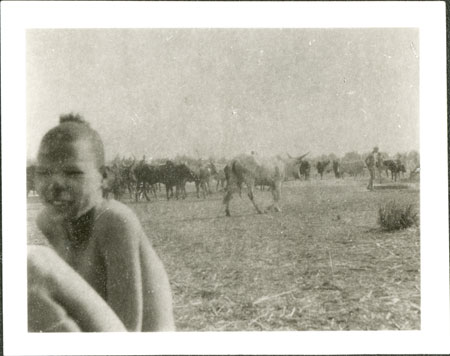Nuer cattle

40 x 30 mm | Print 35mm contact
There are records relating to alternative images that we do not have scans for in the database:
1998.346.195.1 - Negative film nitrate , (40 x 30 mm)
1998.346.195.1 - Negative film nitrate , (40 x 30 mm)
Date of Print:
Unknown
Previous PRM Number:
EP.N.195
Previous Other Number:
4
Accession Number:
1998.346.195.2
Description:
A youth sits in the foreground whilst cattle wander towards wells, one of which is just visible to the right with a man standing beside it with a stick.
Such wells were dug in river beds in areas such as the Nyanding River occupied by Jimac and Gaaliek secondary sections of the Mor primary section of the Lou.
This practice seems to have been restricted to the Lou and Eastern Jikany Nuer tribes, although less so after their territorial advance as far as the Sobat River and other rivers.
It involved re-digging each season to provide a water source of about a foot in depth.
Troughs for cattle were often placed around the holes, which belonged to a household..
Photographer:
Edward Evan Evans-Pritchard
Date of Photo:
1931
Region:
[Southern Sudan] Upper Nile or Jonglei
Group:
Nuer ?Lou
PRM Source:
Edward Evan Evans-Pritchard
Acquired:
Donated 1966
Other Owners:
E. E. Evans-Pritchard Collection
Class:
Water Supply , Animal Husbandry
Keyword:
Well , Animal Cattle
Documentation:
Original catalogue lists in Manuscript Collections. Additional material in related documents files. [CM 27/9/2005]
Primary Documentation:
Accession Book Entry: [p.
98] 1966.27 [1 - 24] G[ift] PROFESSOR E.
E.
EVANS-PRITCHARD; INST.
OF SOCIAL ANTHROPOLOGY, 51 BANBURY RD.
OXFORD 1966.27.17 S.
SUDAN.
NUER TRIBE.
Box of negatives each in separate envelope, labelled.
(some missing).
Nos.
1 - 213.
(prints in box 1966.27.18)...1966.27.18 S.
SUDAN.
NUER TRIBE.
Box of prints each in separate envelope.
Nos.
1 - 213.
(negatives in 1966.27.17.)
Manual Catalogues [typewritten, entitled "Nuer Photographs (E-P)"] - 195. Cattle. (S.) [small size]
Note on print reverse ms pencil - "4 195 "
Manual Catalogues [typewritten, entitled "Nuer Photographs (E-P)"] - 195. Cattle. (S.) [small size]
Note on print reverse ms pencil - "4 195 "
Recorder:
Christopher Morton [20/4/2004] [Southern Sudan Project]

